
Senecio is a genus of flowering plants in the daisy family (Asteraceae) that includes ragworts and groundsels. The scientific Latin genus name, Senecio, means "old man".

A houseplant is a plant that is grown indoors in places such as residences and offices, namely for decorative purposes, but studies have also shown them to have positive psychological effects. They also help with indoor air purification, since some species, and the soil-dwelling microbes associated with them, reduce indoor air pollution by absorbing volatile organic compounds including benzene, formaldehyde, and trichloroethylene. While generally toxic to humans, such pollutants are absorbed by the plant and its soil-dwelling microbes without harm.
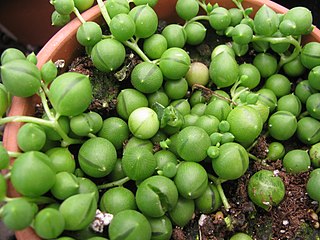
Curio rowleyanus, syn. Senecio rowleyanus, is a flowering plant in the daisy family Asteraceae. It is a creeping, perennial, succulent vine native to the drier parts of southwest Africa. In its natural environment its stems trail on the ground, rooting where they touch and forming dense mats. It often avoids direct sunlight by growing in the shade of other plants and rocks. It is commonly known as string-of-pearls or string-of-beads.

Senecio angulatus, also known as creeping groundsel and sometimes as Cape ivy, is a succulent plant from the family Asteraceae of the genus Senecio that is native to South Africa. It is a scrambling and a twining herb that can become an aggressive weed once established, making it an invasive species in some countries. However, it is grown as an ornamental plant for its satiny foliage and sweet-scented flowers.

Senecio tamoides, also known as Canary creeper, is a climbing member of the genus Senecio of the family Asteraceae that is native to Southern Africa. It is used as an ornamental plant for its showy yellow, daisy-like flowers in autumn.
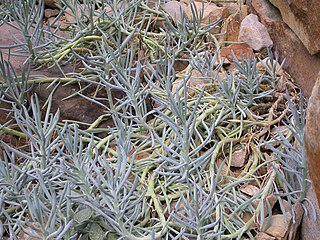
Curio ficoides, syn. Senecio ficoides, also known as skyscraper Senecio and Mount Everest Senecio, is a species of succulent plant, in the genus Curio (Asteraceae), indigenous to South Africa.

Curio archeri, syn. Senecio toxotis is a species of succulent plant in daisy family that is indigenous to the south-western Cape, South Africa.
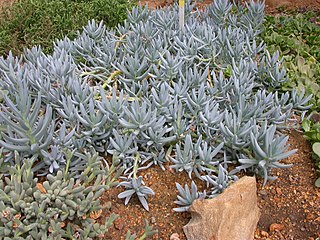
Curio repens, syn. Senecio serpens, is a species of the genus Curio in the Asteraceae family. A succulent endemic to the Western Cape province of South Africa, it is typically found growing from crevices in rocky sandstone slopes. Commonly named blue chalksticks, it is used as an ornamental plant.

Euphorbia mammillaris is a plant species endemic to Cape Province of South Africa. It grows up to 18 cm in height, with succulent stems covered with gray spines.
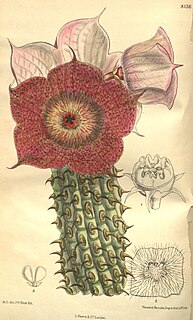
Hoodia currorii is a succulent plant native to Namibia and the Cape Province of South Africa. It grows in desert areas and is common along the road from Karibib to Swakopmund in Namibia. It is also known as ghaap in the vernacular.

Kalanchoe longiflora, also known as tugela cliff-kalanchoe or long-flower kalanchoe, is a species of the succulent genus Kalanchoe, in the family Crassulaceae. An obscure shrub native to South Africa, it is known for its multi-coloured foliage and yellow flowers, which bloom in autumn to winter.
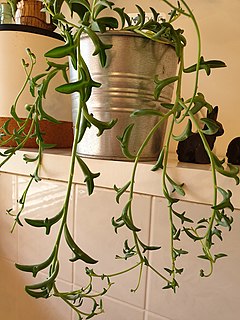
Curio × peregrinus, also known as dolphin necklace, flying dolphins, string of dolphins, dolphin plant or Senecio hippogriff, is a succulent nothospecies of Curio in the family Asteraceae. It is often called, incorrectly, Senecio peregrinus, but that name was previously given, by Grisebach in 1879, to a different species from South America. The name Curio × peregrinus was published in 1999, based on the earlier name Kleinia peregrina; however, this name was not validly published. The plant is a hybrid between Curio rowleyanus and Curio articulatus.

Curio is a genus of flowering plant in the family Asteraceae. Plants in the genus are evergreen succulents with long, striated leaves and discoid flower heads lacking ray florets.

Curio articulatus, syn. Senecio articulatus, which is also known as candle plant, pickle plant and hot dog cactus, is a deciduous succulent plant that is native to South Africa.

Curio herreanus, syn. Senecio herreanus, which is also known as string of watermelons, string of beads, gooseberry plant and string of raindrops, is a flowering succulent plant in the daisy family Asteraceae that is native to South Africa. It is grown as an ornamental plant and is very similar in appearance to 'string of pearls', where the names may be conflated.

Curio talinoides, syn. Senecio mandraliscae, also known as blue straws, blue chalksticks, dassieharpuis, or narrow-leaf chalk sticks, is a succulent plant of the sunflower family that is native to South Africa. The origin of this plant is dubious and it may be a hybrid.
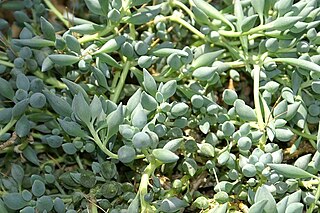
Curio citriformis, syn. Senecio citriformisis, also known as string of tears, is a trailing succulent plant in the sunflower family native to South Africa that grows in rocky outcrops in clay soils.

Curio hallianus, syn. Senecio hallianus, is a creeping succulent plant in the daisy family Asteraceae that is native to South Africa.

Senecio candicans, commonly known as angel wings and sea cabbage, is a succulent flowering plant in the Senecio genus that is native to India and is grown as an ornamental plant elsewhere.

Senecio tropaeolifolius, which is known as false nasturtium or nasturtium-leaf spearhead is a succulent plant in the daisy family that is native to South Africa.
























